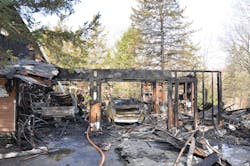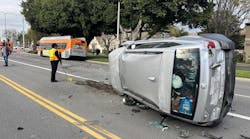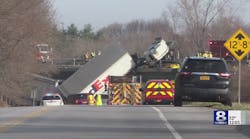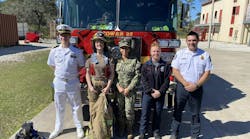SUBJECT: High-Voltage Lithium-Ion Vehicle Batteries
TOPIC: Thermal Events
OBJECTIVE: Upon the conclusion of this series, the fire service responder will have a better understanding of the thermal events that can and have occurred involving liquid-cooled, high-voltage batteries at vehicle collision or fire-related incidents. (Note: There have been no vehicle fires as a result of real-world crashes involving electric vehicles.)
TASK: Upon the conclusion of this series, fire service responders shall be able to develop department guidelines for dealing with liquid-cooled, high-voltage batteries at a vehicle collision or fire-related incident.
In Part 1, we learned that the 360-volt battery is liquid cooled in order to maintain its optimal operating temperature. The battery coolant is just over six quarts of standard General Motors (GM) antifreeze. We also noted that the T-shaped high-voltage battery is mounted inside the center tunnel area of the vehicle. This Part 2 article provides an overview of several fire incidents during 2011 in which a Chevrolet VOLT was present and explains what investigators determined happened in each case. These case study incidents resulted in the National Highway Traffic Safety Administration (NHTSA) issuing interim recommendations for responders when dealing with hybrid or electric vehicle collisions or fires involving a high-voltage battery.
Barkhamstead, CT
A structure fire was reported to the Litchfield County Dispatch Center at approximately 04:12 hours on April 14, 2011, on a rural road in Barkhamsted. Responding firefighters from Barkhamsted, with assistance from six other mutual aid fire departments, arrived to find a single-family residence with its attached, two-car garage fully involved. The aggressive, offensive attack by the firefighters with a pre-connected 2½-inch attack line knocked down the body of fire and essentially saved the two-story home. As the smoke cleared, the remains of two burnt vehicles were visible inside the garage – one a 2011 Chevrolet Volt.
What caught the attention of the news media was the fact that an electric Volt was involved and the possibility that it could have been the origin of the fire. This would have been the first structural fire or total loss vehicle fire involving a mass-produced electric vehicle in the U.S. However, the investigation determined that the Volt was simply a “victim” of the garage fire. The origin of the fire was determined to be in the area of electrical wiring plugged into the vehicle next to the Volt: a 1987 Suzuki Samurai vehicle that had been modified into an all-electric vehicle by the homeowner.
Although investigators cleared the Volt of being the point of origin in the garage fire, the burned Volt experienced what could best be described as an unexpected electrical shorting incident days later. Three days after the fire, moisture from overnight rain mixed with the coolant inside the Volt’s fire-damaged lithium-ion high-voltage battery and caused electrical short circuiting of the battery. There was no damage caused in this near-rekindle but the message was clear: collision or fire-damaged high-voltage batteries may need to be treated differently by the fire service.
Mooresville, NC
On Sunday, October 30, yet another garage, with a Chevrolet Volt parked inside, caught fire; this time in North Carolina. The fire started inside an attached three-bay garage of a 5,700-square-foot home in Mooresville. The 2011 Volt, plugged into a Siemens-brand 240-volt electric vehicle recharging station in the garage, was in one bay, along with a 2007 Nissan Armada SUV in the second bay, and a variety of household objects and toys in the third bay. Again, media attention focused on whether the Volt or its charger had caused the fire. Iredell County Chief Deputy Fire Marshal Garland Cloer’s investigation determined that in fact, the Volt was once again just a fire “victim” and not the probable cause of the reported $1.2 million fire loss. The fire is still under investigation. This time, however, the high-voltage battery inside the burnt Chevrolet Volt was “stabilized” and drained of its coolant fluid at the scene by GM technicians. There was no further issue with this stabilized battery.
Burlington, WI
As far as the fire service knew at that time, there had been only two structure fire incidents involving a Chevrolet Volt. The reality was that another Volt had burned; and this time it was the Volt that investigators believe did cause the fire. In early May of 2011, at a special facility in Burlington, WI, several 2011 Volt vehicles were crash tested as part of the government’s new car assessment program. One Volt, which was used for the 20-mph rigid pole side-impact crash test, spontaneously caught fire three weeks later while parked along a roadway outside of the testing facility. Investigators discovered that the side-impact crash test that the Volt experienced had physically damaged the cells of the lithium-ion battery and caused the glycol battery coolant to leak. The partial charge left in the damaged battery, along with the leaking battery coolant inside the battery casing, is what investigators state resulted in an electrical fire that not only destroyed the Volt but three other vehicles parked nearby. Because the fire occurred over a weekend in a remote area of the test facility, all the fires burned themselves completely out before anyone even became aware that there had been a fire at all.
NHTSA Vehicle & Battery Crash Testing
After the May Wisconsin fire incident, NHTSA began crash testing other Volts to recreate the fire scenario. They also intentionally damaged three Volt lithium-ion, high-voltage batteries from Chevrolet Volts as part of their investigation into the Wisconsin test lab fire incident. During their research, one damaged Volt battery began to smoke and emit sparks when turned upside down during its testing. A second Volt battery, sitting on a rack in a storage shed, spontaneously self-ignited seven days after it had been intentionally damaged. Both the battery and the storage shed were destroyed in the fire.
As a result of this testing, where there was no longer any doubt that in fact the Volt battery was the origin of the fire, NHTSA produced a document containing recommended guidelines for first responder agencies to follow when confronted with a crash-damaged or fire-damaged lithium-ion high-voltage battery. A close analytical look at these protocols will be the featured in Part 3 of this University of Extrication series.
TASK: Upon the conclusion of this series, fire service responders shall be able to develop department guidelines for dealing with liquid-cooled, high-voltage batteries at a vehicle collision or fire-related incident.






